alb5144340
Ithyphallic slave with support wood, clay, hand modelled, pressed into the mould, fired (ceramic), Total: Height: 13.4 cm; Width: 11.8 cm; Depth: 5 cm (without phallus); Depth: 9.3 cm (with phallus), Ceramics, armor, armour, armour, headgear, Early Imperial Period, The broad-legged slave, moving forward, naked except for a short skirt and equipped with a removable, oversized phallus, dragging heavily on his load - again an oversized penis - hanging from a wooden support placed over his shoulder. Both hands hold the ropes of the supporting wood to relieve the pressure on the shoulders. On top of his lush, curly hair he wears a pointed hat with a bow at the front. The grotesquely oversized phallus characterizes the figure in its low social position, which he caricatures as being drive-driven. The cap with the bow also betrays him as a lucky gift. Replicas of male limbs were made especially for Dionysus' celebrations. The small person is thus directly related to this fertility cult. The figure belongs to the group of the so-called Fayum terracottas. Alexandria, the international, Greek-influenced center of Egypt, is home to a multicultural society of Egyptians, Orientals, Greeks, Romans, Jews, and others whose different religious ideas are gradually merging. Insights into this world of faith are provided by the so-called Fayum terracottas. They are part of the religious household, children's toys, knick-knacks, but also cult symbols, grave goods, pilgrimage images, votive offerings and magical objects for banishing evil forces. They can be found in houses, graves and sanctuaries.

|
Añadir a otro lightbox |
|
Añadir a otro lightbox |



¿Ya tienes cuenta? Iniciar sesión
¿No tienes cuenta? Regístrate
Compra esta imagen

Descripción:
Ver traducción automática
Ithyphallic slave with support wood, clay, hand modelled, pressed into the mould, fired (ceramic), Total: Height: 13.4 cm; Width: 11.8 cm; Depth: 5 cm (without phallus); Depth: 9.3 cm (with phallus), Ceramics, armor, armour, armour, headgear, Early Imperial Period, The broad-legged slave, moving forward, naked except for a short skirt and equipped with a removable, oversized phallus, dragging heavily on his load - again an oversized penis - hanging from a wooden support placed over his shoulder. Both hands hold the ropes of the supporting wood to relieve the pressure on the shoulders. On top of his lush, curly hair he wears a pointed hat with a bow at the front. The grotesquely oversized phallus characterizes the figure in its low social position, which he caricatures as being drive-driven. The cap with the bow also betrays him as a lucky gift. Replicas of male limbs were made especially for Dionysus' celebrations. The small person is thus directly related to this fertility cult. The figure belongs to the group of the so-called Fayum terracottas. Alexandria, the international, Greek-influenced center of Egypt, is home to a multicultural society of Egyptians, Orientals, Greeks, Romans, Jews, and others whose different religious ideas are gradually merging. Insights into this world of faith are provided by the so-called Fayum terracottas. They are part of the religious household, children's toys, knick-knacks, but also cult symbols, grave goods, pilgrimage images, votive offerings and magical objects for banishing evil forces. They can be found in houses, graves and sanctuaries.
Personas:
Crédito:
Album / quintlox
Autorizaciones:
Modelo: No - Propiedad: No
¿Preguntas relacionadas con los derechos?
¿Preguntas relacionadas con los derechos?
Tamaño imagen:
3614 x 4320 px | 44.7 MB
Tamaño impresión:
30.6 x 36.6 cm | 12.0 x 14.4 in (300 dpi)
Palabras clave:
ADORNO • ALEJANDRIA • ALFARERIA • ARCILLA • ARMADURA • ARMADURAS • BAJORRELIEVE • BAJORRELIEVES • CAPA • CASA • CASAS • CERAMICA • CERÁMICO • COLGANDO • CORAZA • CREENCIA • DECORACION • DISPARARON • EGIPCIA • EGIPCIAS • EGIPCIO • EGIPCIOS • EGIPTO • EN RELIEVE • EQUIPADA • EXVOTOS • FE • FIGURA • FRONTAL • GORRO • GRIEGOS • GROUP • GRUPO • GRUPO. • HOGAR • HOMBRO • HOMBROS • INTERNACIONAL • JUDIO • MOLDE • MUNDO • OBJETO DE CERAMICA • ORNAMENTO • PELO RIZADO • PRESIÓN • PRESIÓN, LA • PRESIONADO • PROFUNDIDAD • RELIEF • RELIEVE (ARTE) • RELIEVES • RELIGION • REPLICAS • ROMANOS • SHOULDERS • TERRACOTA • TERRACOTTA • TUMBAS
 Pinterest
Pinterest Twitter
Twitter Facebook
Facebook Copiar enlace
Copiar enlace Email
Email
